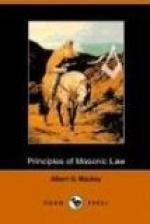A similar interpretation seems at all times to have been given by the Grand Lodges of the United States, with the exception of some, who, within a few years past, have begun to adopt a more latitudinarian construction.
In Pennsylvania it was declared, in 1783, that candidates are not to be “deformed or dismembered at the time of their making.”
In South Carolina the book of Constitutions, first published in 1807, requires that “every person desiring admission must be upright in body, not deformed or dismembered at the time of making, but of hale and entire limbs, as a man ought to be.”
In the “Ahiman Rezon and Masonic Ritual,” published by order of the Grand Lodge of North Carolina and Tennessee, in the year 1805, candidates are required to be “hale and sound, not deformed or dismembered at the time of their making."[62]
Maryland, in 1826, sanctioned the Ahiman Rezon of Cole, which declares the law in precisely the words of South Carolina, already quoted.
In 1823, the Grand Lodge of Missouri unanimously adopted a report, which declared that all were to be refused admission who were not “sound in mind and all their members,” and she adopted a resolution asserting that “the Grand Lodge cannot grant a letter or dispensation to a subordinate lodge working under its jurisdiction, to initiate any person maimed, disabled, or wanting the qualifications establishing by ancient usage."[63]
But it is unnecessary to multiply instances. There never seems to have been any deviation from the principle that required absolute physical perfection, until, within a few years, the spirit of expediency[64] has induced some Grand Lodges to propose a modified construction of the law, and to admit those whose maims or deformities were not such as to prevent them from complying with the ceremonial of initiation. Still, a large number of the Grand Lodges have stood fast by the ancient landmark, and it is yet to be hoped that all will return to their first allegiance. The subject is an important one, and, therefore, a few of the more recent authorities, in behalf of the old law may with advantage be cited.
“We have examined carefully the arguments ‘pro and con,’ that have accompanied the proceedings of the several Grand Lodges, submitted to us, and the conviction has been forced upon our minds, even against our wills, that we depart from the ancient landmarks and usages of Masonry, whenever we admit an individual wanting in one of the human senses, or who is in any particular maimed or deformed.”—Committee of Correspondence G. Lodge of Georgia, 1848, page 36.
“The rationale of the law, excluding persons physically imperfect and deformed, lies deeper and is more ancient than the source ascribed to it.[65] It is grounded on a principle recognized in the earliest ages of the world; and will be found identical with that which obtained among the ancient Jews. In this respect the Levitical law was the same as the masonic, which would not allow any ‘to go in unto the vail’ who had a blemish—a blind man, or a lame, or a man that was broken-footed, or broken-handed, or a dwarf, &c....




